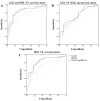STAT1 expression and HPV16 viral load predict cervical lesion progression
- PMID: 32774501
- PMCID: PMC7405543
- DOI: 10.3892/ol.2020.11889
STAT1 expression and HPV16 viral load predict cervical lesion progression
Abstract
Cervical cancer is the fourth leading cause of cancer-associated mortality worldwide. However, its underlying molecular mechanisms are unclear. It is important to explore these mechanisms in order to identify novel diagnostic and prognostic biomarkers. The present study determined the association between STAT1 and human papillomavirus (HPV)16 in cervical lesions. STAT1 expression was detected by immunohistochemistry. Quantitative PCR was used to detect HPV16 viral load and STAT1 expression in cervical lesions. The potential associations among STAT1 expression, HPV16 viral load and the severity of cervical lesions in patients were analyzed using receiver operating characteristic (ROC) curves. The Cancer Genome Atlas database was used to analyze STAT1 expression and survival. High STAT1 expression was observed in 10.71 (3/28), 41.18 (14/34), 53.06 (26/49) and 90.00% (27/30) of normal tissue, low-grade squamous intraepithelial lesion (LSIL), high-grade squamous intraepithelial lesion (HSIL) and cervical squamous cell carcinoma samples, respectively. The HPV16 copy number gradually increased with the progression of cervical lesions, with the highest copy number observed in cervical cancer samples. In addition, STAT1 expression was positively correlated with HPV16 viral load. Furthermore, ROC curve analysis demonstrated that the combination of STAT1 expression and HPV16 viral load was able to differentiate between LSIL/HSIL and cervical cancer samples. Bioinformatics analysis revealed that STAT1 expression was associated with improved survival in cervical cancer. Additionally, STAT1 expression was positively associated with the progression of cervical lesions, and HPV16 viral load may affect STAT1 expression. Overall, these findings indicate that STAT1 may be an indicator of the status of cervical lesions.
Keywords: STAT1; bioinformatics; cervical lesion/cervical cancer; human papillomavirus strain 16; viral load.
Copyright: © Wu et al.
Figures




Similar articles
-
[Viral load, genomic integration frequency of human papillomavirus 16 in cervical cancer and precancerous lesions].Zhonghua Yi Xue Za Zhi. 2011 Apr 5;91(13):906-10. Zhonghua Yi Xue Za Zhi. 2011. PMID: 21600119 Chinese.
-
Physical state & copy number of high risk human papillomavirus type 16 DNA in progression of cervical cancer.Indian J Med Res. 2014 Apr;139(4):531-43. Indian J Med Res. 2014. PMID: 24927339 Free PMC article.
-
HPV16 viral load and physical state measurement as a potential immediate triage strategy for HR-HPV-infected women: a study in 644 women with single HPV16 infections.Am J Cancer Res. 2018 Apr 1;8(4):715-722. eCollection 2018. Am J Cancer Res. 2018. PMID: 29736316 Free PMC article.
-
HPV genotype distribution and anomalous association of HPV33 to cervical neoplastic lesions in San Luis Potosí, Mexico.Infect Agent Cancer. 2016 Mar 30;11:16. doi: 10.1186/s13027-016-0063-z. eCollection 2016. Infect Agent Cancer. 2016. PMID: 27030798 Free PMC article.
-
Integrative and episomal forms of genotype 16 of human papillomavirus in patients with cervical intraepithelial neoplasia and cervical cancer.Vopr Virusol. 2016 Dec 28;61(6):270-274. doi: 10.18821/0507-4088-2016-61-6-270-274. Vopr Virusol. 2016. PMID: 36494986
Cited by
-
Immune Responses in Oral Papillomavirus Clearance in the MmuPV1 Mouse Model.Pathogens. 2023 Dec 14;12(12):1452. doi: 10.3390/pathogens12121452. Pathogens. 2023. PMID: 38133335 Free PMC article.
-
Bovine Delta Papillomavirus E5 Oncoprotein Interacts With TRIM25 and Hampers Antiviral Innate Immune Response Mediated by RIG-I-Like Receptors.Front Immunol. 2021 Jun 10;12:658762. doi: 10.3389/fimmu.2021.658762. eCollection 2021. Front Immunol. 2021. PMID: 34177899 Free PMC article.
-
Nuclear factor IB is downregulated in vulvar squamous cell carcinoma (VSCC): Unravelling differentially expressed genes in VSCC through gene expression dataset analysis.Oncol Lett. 2021 May;21(5):381. doi: 10.3892/ol.2021.12642. Epub 2021 Mar 16. Oncol Lett. 2021. PMID: 33841565 Free PMC article.
-
Network pharmacology-based strategy to investigate the effect and mechanism of α-solanine against glioma.BMC Complement Med Ther. 2023 Oct 21;23(1):371. doi: 10.1186/s12906-023-04215-1. BMC Complement Med Ther. 2023. PMID: 37865727 Free PMC article.
-
Expression and Prognostic Significance of PDIA3 in Cervical Cancer.Int J Genomics. 2022 Nov 11;2022:4382645. doi: 10.1155/2022/4382645. eCollection 2022. Int J Genomics. 2022. PMID: 36406049 Free PMC article.
References
LinkOut - more resources
Full Text Sources
Research Materials
Miscellaneous
